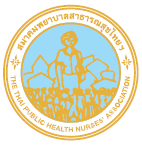ความสัมพันธ์ของพฤติกรรมการดื่มแอลกอฮอล์และผลลัพธ์ทางคลินิกของผู้เป็นความดันโลหิตสูงในชุมชน*
Keywords:
พฤติกรรมการดื่มแอลกอฮอล์, ผลลัพธ์ทางคลินิก, ความดันโลหิตสูง, ทฤษฏีระบบนิเวศวิทยา, alcohol consumption behaviors, clinical outcomes, hypertension, ecological system theory frameworkAbstract
การศึกษาครั้งนี้เป็นวิจัยแบบบรรยายเชิงวิเคราะห์ความสัมพันธ์มีวัตถุประสงค์เพื่อศึกษาปัจจัยที่มีความสัมพันธ์กับพฤติกรรมการดื่มแอลกอฮอล์และผลลัพธ์ทางคลินิกของผู้เป็นความดันโลหิตสูงในชุมชนเขตอำเภอเมืองนนทบุรี จังหวัดนนทบุรี จำนวน 213 คัดเลือกตัวอย่างแบบเฉพาะเจาะจงใช้กรอบแนวคิดทฤษฏีระบบนิเวศวิทยาในการศึกษา เก็บข้อมูลโดยการสัมภาษณ์จากแบบสอบถาม การประเมินภาวะโภชนาการและการตรวจทางห้องปฏิบัติการวิเคราะห์ข้อมูลด้วยสถิติบรรยาย สถิติสหสัมพันธ์แบบเพียร์สันและสถิติไคสแควร์
ผลการศึกษา พบว่าตัวอย่างส่วนใหญ่ เป็นเพศชาย (ร้อยละ 69.5) อายุเฉลี่ย 56.24 ปี สถานภาพสมรสคู่ (ร้อยละ 76.4) ได้รับการศึกษาในระดับประถมศึกษา (ร้อยละ 49.2) ประกอบอาชีพรับจ้าง (ร้อยละ 43.7) คนใกล้ชิดที่มีพฤติกรรมการดื่มแอลกอฮอล์พบมากที่สุดคือเพื่อนร่วมงาน (ร้อยละ 55.9) มีสัมพันธภาพภายในครอบครัวอยู่ในระดับดี (ร้อยละ 52.6) แรงสนับสนุนทางสังคมอยู่ในระดับมาก (ร้อยละ 54.0) และความเชื่อเกี่ยวกับแอลกอฮอล์และพฤติกรรมสุขภาพอยู่ในระดับปานกลาง (ร้อยละ 66.7) พฤติกรรมการดื่มแอลกอฮอล์พบ 1 ปีที่ผ่านมาปริมาณการดื่มแอลกอฮอล์เฉลี่ยต่อวันเท่ากับ 2.58 ดื่มมาตรฐาน ความถี่ในการดื่มคือ ดื่ม 2-3 วันต่อเดือน (ร้อยละ30.5) ผลลัพธ์ทางคลินิกพบค่าความดันซิสโตลิกสูงกว่าปกติ ร้อยละ 31.9 ค่าความดันไดแอสโตลิกสูงกว่าปกติ ร้อยละ 27.2 พบโปรตีนในปัสสาวะ ร้อยละ 16.3 ไมโครอัลบูมินในปัสสาวะผิดปกติ ร้อยละ 25.8 และอัตราการกรองผ่านโกลเมอรูลัส พบมีการทำงานของไตผิดปกติระยะที่ 3 ร้อยละ 10.3 ผลการวิเคราะห์ความสัมพันธ์พบว่าปัจจัยที่มีผลต่อพฤติกรรมการดื่มแอลกอฮอล์ได้แก่ เพศ (c2 = 15.338, p-value <.001) ความเชื่อเกี่ยวกับแอลกอฮอล์และพฤติกรรมสุขภาพ (r=-.235, p-value =.001) พฤติกรรมการดื่มแอลกอฮอล์มีความสัมพันธ์กับผลลัพธ์ทางคลินิกได้แก่ ไมโครอัลบูมินในปัสสาวะ (r=.140, p-value =.041) และ โปรตีนในปัสสาวะ (r=.164, p-value = .016)
ผลการศึกษาครั้งนี้มีข้อเสนอแนะต่อพยาบาลเวชปฎิบัติชุมชนในการประเมินปัจจัยที่มีความสัมพันธ์กับพฤติกรรมการดื่มแอลกอฮอล์ของผู้เป็นความดันโลหิตสูงอย่างครอบคลุม รวมทั้งการจัดทำและพัฒนาแนวทางการดูแลระดับปฐมภูมิให้กับผู้เป็นความดันโลหิตสูง ที่มีพฤติกรรมการดื่มแอลกอฮอล์ และมีผลลัพธ์ทางคลินิกที่ผิดปกติ โดยเน้นการแก้ไขปัญหาในเพศชายและมีความเชื่อในการคลายความเครียดไม่ถูกต้องเพื่อป้องกันภาวะแทรกซ้อนที่จะเกิดขึ้น
ASSOCIATION OF ALCOHOL CONSUMPTION BEHAVIORS AND CLINICAL OUTCOMES IN PERSONS WITH HYPERTENSION IN COMMUNITIES
ABSTRACT
This study was descriptive correlational research. The purpose of this research was to examine factors related to alcohol consumption behaviors and clinical outcomes in persons with hypertension in communities in AmphoeMuangNonthaburi, Nonthaburi province. Through purposive sampling, 213 people with hypertension who drink alcohol were selected.
The ecological system theory was used as the conceptual framework. Data were collected using structured interview, nutritional assessment, and laboratory test. Data were analyzed using descriptive statistics, Pearson’s Product Moment Correlation, and Chi Square test
Results revealed that the majority of the sample were male (69.5%), with mean age of 56.24 years, were married (76.4%), obtained primary education (49.2%) and were employed (43.7%). Colleagues were found at the highest frequency (55.9%) among close persons who have alcohol consumption behavior. In addition their beliefs about alcohol and health behaviors were moderate (66.7%). However their family relationships were good (52.6%) and social support was high (54.0%). The alcohol consumption behaviors over one year was at an average of 2.58 drinks with a frequency of about 2-3 days per month (30.5%). As a result, the clinical outcomes showed that their systolic blood pressure was higher than normal (31.19%) and the diastolic blood pressure was higher than normal (27.2%). Proteinuria was 16.3% and abnormal microalbuminuria was 25.8%. The glomerular filtration rate indicated renal dysfunction stage 3 (10.3%). Factors related to alcohol consumption behaviors were gender (x2 = 15.338, p-value < .001) and beliefs of alcohol and health behavior (r = -. 235, p-value = .001). The alcohol consumption behaviors related with clinical outcomes including microalbuminuria (r = .140, p-value = .041) and proteinuria (r = .164, p-value = .016).
The results of this study suggest that community nurse practitioners assess factors related to alcohol consumption behaviors and develop approaches to provide primary care for those who have hypertension and alcohol consumption behaviors, along with clinical outcomes disorder, especially in males who have inappropriate belief of relaxation in order to prevent complications.
Downloads
Published
How to Cite
Issue
Section
License
บทความที่ตีพิมพ์และแผนภูมิรูปภาพถือเป็นลิขสิทธิ์ของวารสารพยาบาลสาธารณสุข (Thai Public Health Nurses Association)






